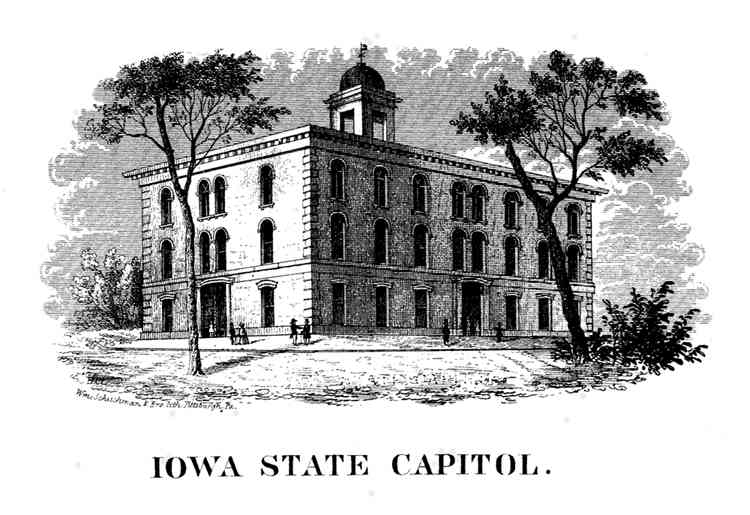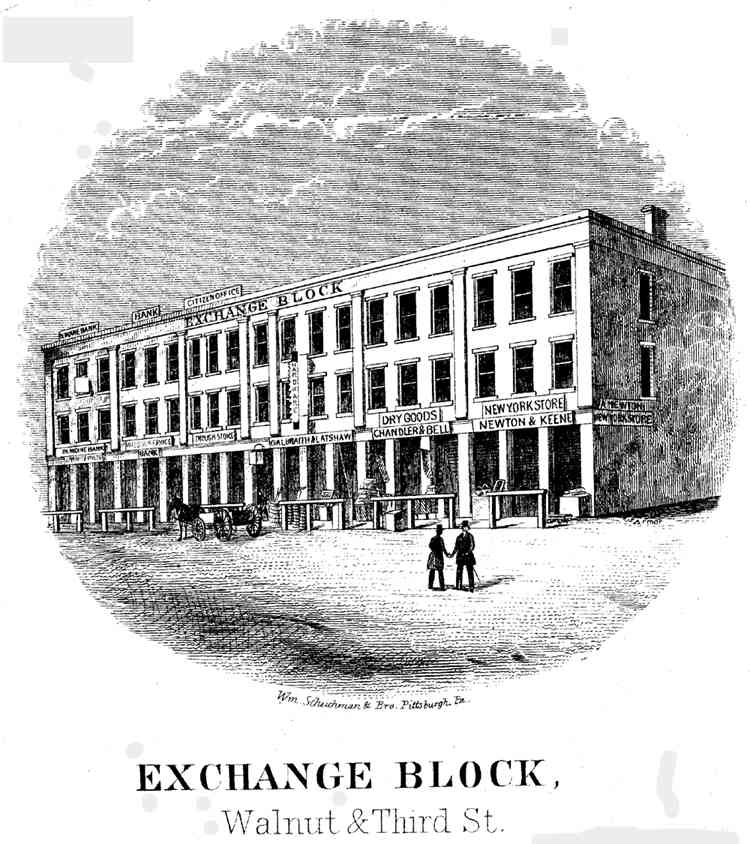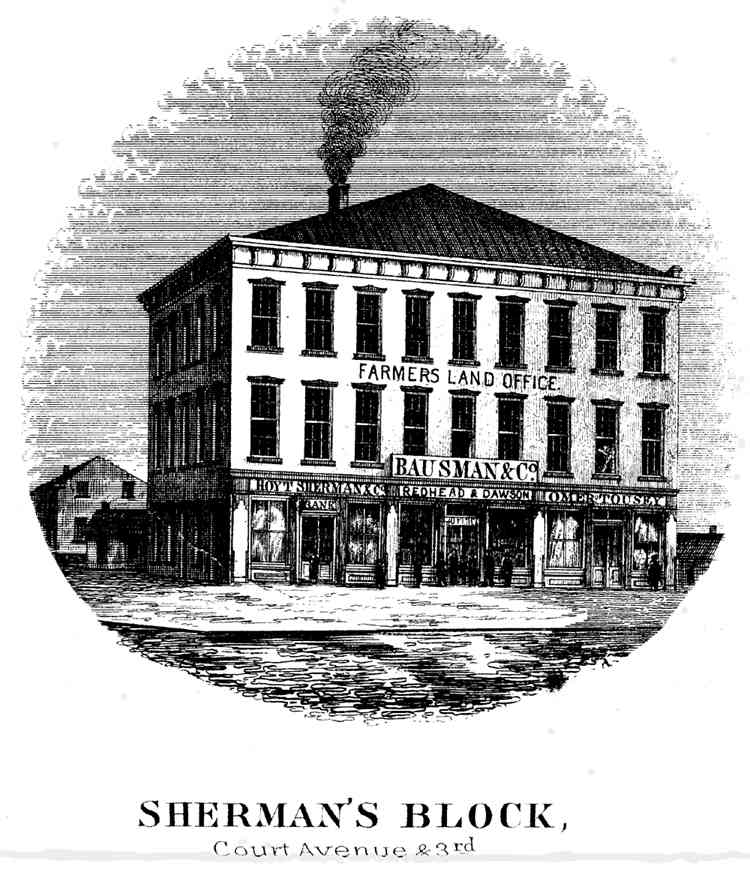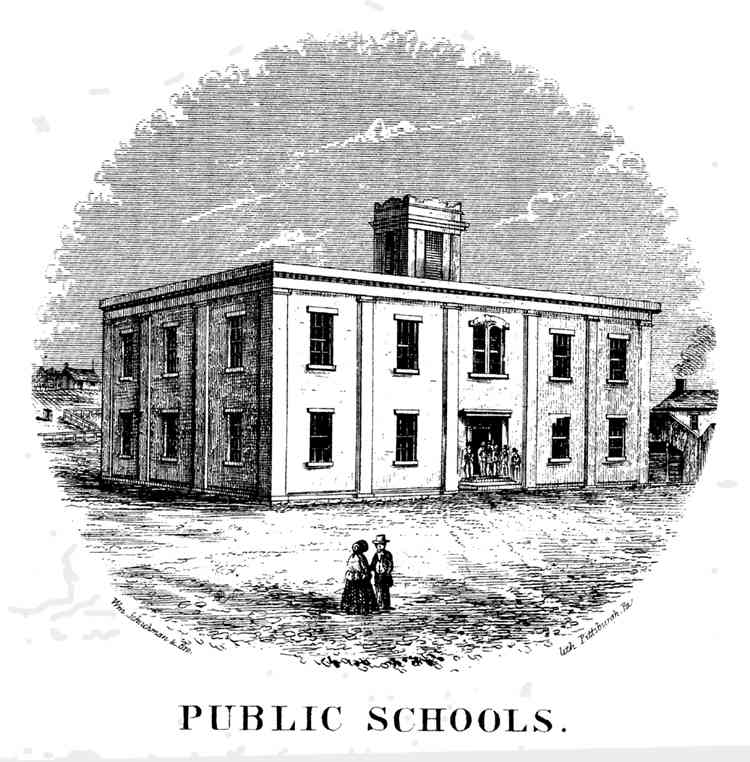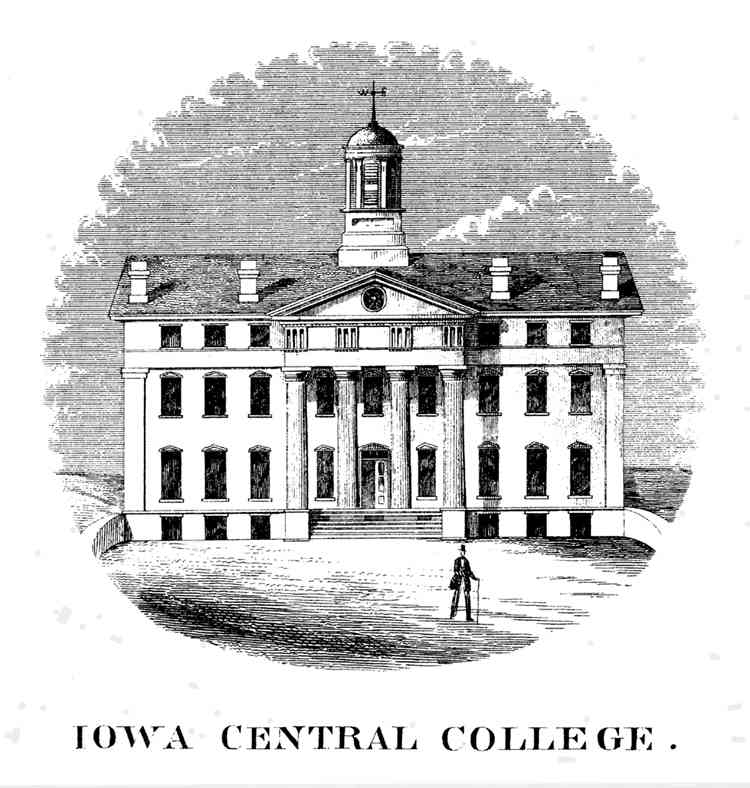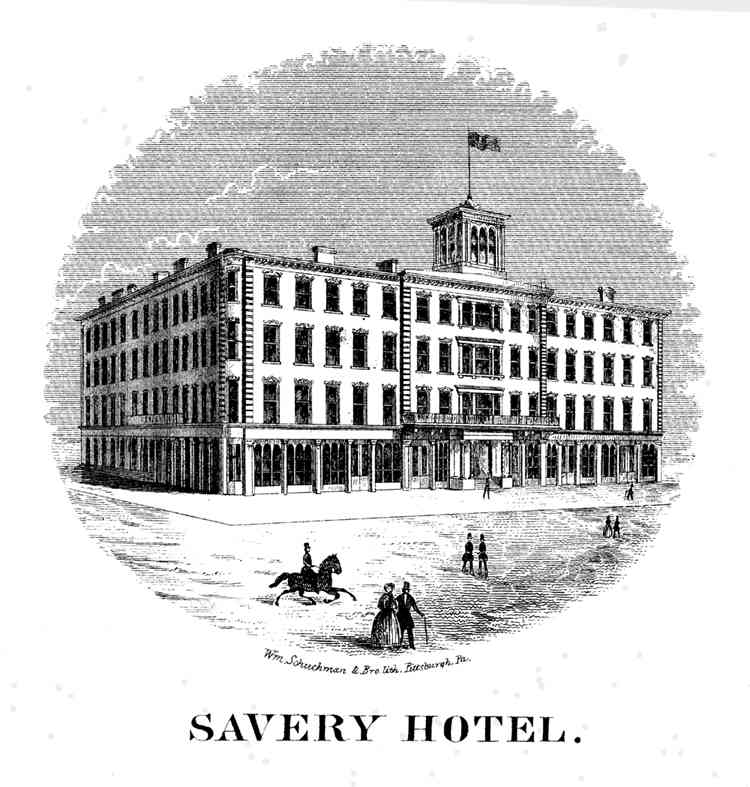HISTORY OF DES MOINES.
DESCRIPTIVE SKETCH OF DES MOINES.
Source: Historical reminiscences of the city of Des Moines, together with a full description of the city and county. H. B. Turrill, 1857. Transcribed by Ralph Leonard.
As has been already stated, the original town of Fort Des Moines was laid out in June, 1846. But its extent as then specified, comprises but a small portion of the present limits of our city. Its streets and squares have extended in all directions, and manifold additions have been made to the original plat, both west and east of the Des Moines river.
That part of the city east of the Des Moines, and formerly called East Fort Des Moines, was not, under the town charter, included within the corporation, but the city charter comprises both sides of the river. The eastern side is not so favorable, by nature, for a town site, as the western. The space between the river and the adjacent hills is narrower, and a considerable portion of the valley is low and subject, in time of high water, to be partly overflowed. There is a level stretch of ground near the bluffs that is higher, and were it sufficiently extensive would constitute an admirable site for a town. Still, buildings are being erected throughout the whole bottom, on the slope of the hill where the Capitol is located, and even beyond it. The whole hill side and valley, from present appearances, will in a few years be entirely covered with houses. Some of those now erected are very fine and costly.
On the brows of the surrounding eminences are many very beautiful situations for suburban residences, commanding a view of the entire city, and the Des Moines and its tributary winding around it like belts of glistening silver. On one of the most commanding of these knolls the Capital Building is placed. Although its location has been the theme of much sharp contention between the various rival interests, on either side of the river, there is probably no
(85)
86 DESCRIPTIVE SKETCH
spot where it could have been situated exceeding in natural advantages the beautiful position it now occupies.
For the appended description of the State Capitol we are indebted to the columns of the Iowa Citizen.
“This magnificent superstructure was commenced last July, under the supervision of the 'Capitol Building Committee.' Messrs. Bryant & Hyde were the contractors. Below we give the dimensions of this edifice, as we have obtained them from a reliable source. This superb building is composed of brick, with the window sills and foundations of cut stone. The dimensions of the Capitol are one hundred and fifty feet long, and fifty-six feet wide. The first story is eleven feet and a half high; the second twelve, and the third eighteen feet. The Senate Chamber is fifty-six feet long by thirty-four wide. The Representative Hall is fifty-six feet long by fifty wide. The Supreme Court room is fifty feet long by twenty-four wide. The State Library room is thirty-four by twenty-four, and the State office rooms are each twenty-four by twenty-three feet. The building is roofed with tin, and the style of architecture is Ionic. The height of the dome is eighty-five feet. A bell has been contracted for, weighing fifteen hundred pounds. There is a fire-proof vault, the dimensions of which are nine by eleven feet. The building fronts on the public square on the north, and the city on the west, and will be entirely completed by the first of May, 1857. It will be a substantial and magnificent structure, and will reflect credit upon the enterprise of our citizens, and on our youthful, but flourishing State.” [See engraving.]
The western side of the Des Moines is the natural site of the town, and a finer locality can scarcely be found anywhere. The table-land, so narrow on the east side, here expands into a beautiful and elevated plain, extending to the very verge of the river, and affording ample space for a city of fifty thousand inhabitants, ten times our present population. Near the mouth of the Raccoon the ground
OF DES MOINES. 87
is somewhat lower, and several lakes, fed by springs, may be found; among the most extensive is Horse-shoe Lake, which covers several acres. It derives its name from its semi-circular form. Arrangements are in contemplation to drain these lakes, fill them up, and lay off the ground they occupy in building-lots. What is known as the “Hydraulic Addition” is situated in this quarter. This was a project to reclaim lots from the bed of the Raccoon river, and to force as much as might be necessary of the water of that stream to the summit of Greenwood Hill, west of the city, whence it might be distributed to any part of the city, by conduits, and furnish to the citizens at all times an abundant supply of water; a design certainly deserving of attention and support, if proved practicable.
The dwellings which have been erected in times that are past are such as characterize new towns. Many of them are small, and constructed without the slightest reference to architectural taste, or even convenience and comfort. It is, however, a subject of congratulation that these rude structures are limited in number, and that the great majority of the buildings which have been erected within the last five years are such as would adorn the appearance of older towns than ours. Nearly every new dwelling shows the impress of neatness, and a correct taste, and many of them bear evidence to the skill and supervision of accomplished architects. For a city only ten years from wigwam-age, the beauty of our private dwellings and public buildings excels that of any town in the West. Any one after passing through our various streets and carefully noting the charming appearance of private residences, the taste and art displayed in churches and other public buildings, and then mounting one of the eminences which environ the city and surveying the whole area of streets and squares, houses and garden plots, in one comprehensive and inspiring glance, will concur in the opinion that for beauty of locality, regularity and neatness of appearance, Des Moines is
88 DESCRIPTIVE SKETCH
not surpassed, if it is even equalled (sic), by any town in our flourishing State.
The stores are usually well-built brick or frame houses, large and commodious, and well stocked with choice selections of goods. Most of the business is transacted on Second street, but it is fast diverging into other quarters. All branches of merchandizing are well represented, and to enumerate even their different kinds would be a tedious and useless task.
Manufactories are yet in their infancy in our city. Coal is furnished from mines within the corporation limits, in inexhaustible quantities, and is of good quality for manufacturing purposes. The Des Moines furnishes an adequate supply of water power. A planing, sawing and turning establishment and sash and door manufactory is in successful operation, and doing a large amount of business. A foundry has been established, on the east side, and castings of every variety are made to order. Steam carding machines and cloth dressing, fulling, spinning and weaving machinery are also at work, and, under the superintendence of experienced operators, execute everything in that line in the best style. There are also a number of saw and grist mills, but not enough. For other manufactures our citizens are wholly dependent on the east, but from the advantages here offered, they will undoubtedly soon be established in our midst.
Sherman’s Block is one of the finest and best constructed business buildings in Central Iowa. It stands on the corner of Third street and Court Avenue, is three stories high, with iron front, and cost $25,000. It was completed in 1856. It is occupied on the ground floor by several stores, the Post Office, and Hoyt Sherman & Co.’s Banking-house. The second story is devoted to offices of various kinds, which it is unnecessary to detail; suffice it to say that the office of Hon. W. H. McHenry, Mayor, is one of them. The third story contains a large and finely furnished Hall,
OF DES MOINES. 89
used for public meetings, lectures, balls, concerts, &c. Here is also the studio of W. R. Wheeler, an accomplished resident artist of our city. The building is seventy feet long by sixty-six feet wide, high-roofed and covered with tin, thoroughly painted. It is decidedly an ornament to the city. [See engraving.]
Exchange Block, corner of Third and Walnut streets, was built in 1855, by an association of capitalists, and is the largest business building in the city. It is one hundred and thirty-two feet long by sixty-six feet wide, and three stories high. As its name imports, it is a place of trade, the lower story containing two banks, a drug store, hardware establishments, and two dry goods and grocery stores. The second story is devoted to various uses. Here is the U. S. Land Office. Des Moines Navigation Co.’s rooms, and sundry land and law offices, together with an eating saloon. Passing on to the third story, by various flights of stairs, there will be found a billiard room, Masonic Hall, Citizen printing office, daguerrean gallery, and Odd Fellows’ Hall. The whole cost of this mammoth building was $32,000. [See engraving.]
There are many other edifices of which the citizens of Des Moines feel justly proud, and which reflect credit on the skill and efficiency of our mechanics. The Court House, however, we cannot number among them. It was built some eight years ago, and however well suited for public purposes, and however costly and handsome it might have appeared in the eyes of the people at that time, accustomed as they had been previously to its erection to hold their courts and keep their public records in the log barracks va-cated by the Garrison, it now presents vast and imperative scope and reasons for improvement. It is a shabby, inconvenient, ill-constructed and ill-kept building, and the Jail, if we may still call it by that name, is worthy of the companionship it bears to the Court House. Both of them should be torn down, and more convenient, handsome and
90 DESCRIPTIVE SKETCH
solid buildings erected in their stead. Public opinion already begins to demand it; the growth and business of our city and county require it, and ere long, it is to be hoped, it will be done.
There are seven church buildings in Des Moines, in six of which regular services are performed. One is not yet entirely completed. Six are on the west side of the river, to-wit: Episcopal, Methodist Episcopal, Old and New School Presbyterian, Baptist, and Roman Catholic. On the east side there is but one house of worship, that of the Methodist Episcopal Church. There are various other religious denominations who worship in the large school house, Court House, and such other suitable places as can be obtained, until they are able to erect churches. Our citizens are truly a church-going, if not a religious, people, and the churches are, for the most part, large and neatly built edifices.
Part of the following statement in relation to the Churches in Des Moines is compiled from the Citizen, of March 11th, 1857:
CHRISTIAN CHURCH─REV. N. SUMMERBELL, PASTOR.
THE CHRISTIAN CHURCH, in Des Moines, worships in the large brick school house, on the first floor. Preaching at 11 A. M., and 7 P. M. Young People’s meeting at 3 P. M. Sunday School at 9½ A. M. They have also a Bible class and weekly prayer meeting. The Church numbers thirty communicants, the meetings are well attended, and the Church in a healthy and prosperous condition. They are making arrangements to procure a lot, and expect, the ensuing summer, to build a good chapel.
Date of Organization—Up to July 29th, 1856, there had been no meetings of the Christian denomination in this place. Elder N. Summerbell, then traveling, had two appointments in the Baptist church, but having made choice of this place for a home, the Court House, was procured for permanent meetings, for the time being, and on the 31st
OF DES MOINES. 91
of August, 1856, seventeen believers, having pledged themselves to receive the word of God as their only rule of faith and practice, were organized into a “Christian Church,” according to the custom of the Apostolic Church.
EPISCOPAL CHURCH—REV. E. W. PEET, PASTOR.
The first services of the Episcopal Church, in Des Moines, were begun two years since in the Court House. Rev. E. W. Peet, of New Jersey, resigned his parish in the East, and by invitation of the wardens and vestry of St. Paul’s parish, Des Moines, he took up his residence in this city, in the month of March, 1855, as Rector of the parish, and missionary of the Episcopal Association for the West. The gentlemen composing the vestry at that time were Samuel Case, Madison Young, Byron Rice, Hoyt Sherman, Wm. F. Ayres, John D. McCall, D. O. Finch, and J. W. Morris. The erection of a church was postponed in the hope that accessions would enable them to erect a church suitable to the future prospects of the city. But the inconveniences of having no regular place of meeting proved too great, and a church was begun in the fall of 1856. It is owned by the parish and occupies an eligible site on Seventh street. Besides this, the parish owns a lot—the gift of Mr. E. Hall, in Hall’s addition to Des Moines, and a chapel will be erected on it the ensuing season. The present number of communicants is about twenty-five.
METHODIST EPISCOPAL CHURCH, WEST SIDE─REV. A. C. BARNHART, PASTOR.
A Methodist Society was organized in 1845, by Rev. Mr. Russel, the Methodist Church being, as usual, the pioneer in religious enterprise. The number of communicants, when first organized, was nine, since which time it has increased to one hundred and fifty.
The Methodist Society on the west side occupy, at pres-
92 DESCRIPTIVE SKETCH
ent, the basement of their large brick church, on Fifth street. They have public services every Sabbath morning, at half past ten. Sabbath School at half past one, P. M., and preaching every Sabbath evening.
METHODIST EPISCOPAL CHURCH, EAST SIDE─REV. E. M. H. FLEMMING, PASTOR.
Previous to November, 1855, there was occasional preaching, but no church organization in East Fort Des Moines. At that time it was included in the Marion Circuit. In December, 1855, Rev. E. M. H. Flemming organized a Church (Wesley Chapel) with fourteen persons as members and probationers. This was the first church organization on the east side of the river. In the fall of 1856 East Des Moines was made a station, and in November of the same year the trustees began the erection of a church; and notwithstanding the severity of the winter, succeeded in completing it before spring. The building is neat and comfortable, and is eligibly situated on Keokuk street; seats free. The entire cost of the church and the lot on which it stands was $3,000. Since the organization there has been a gradual increase, and the present number of members and probationers is forty.
METHODIST PROTESTANT CHURCH─REV. WM. REMSBURGH, PASTOR.
The organization of this Church took place on the 22d of May, 1856. The present number of communicants is sixteen. The Church has, as yet, no house of worship, but propose erecting one the coming summer. The present place of meeting is in Mr. Harrison Lyon’s school house. Preaching every Sabbath at 10½ A. M., and also in the evening.
LUTHERAN CHURCH—REV. R. WEISER, PASTOR.
The Lutheran Church was organized on the 7th of July,
OF DES MOINES. 93
1855, with twelve members. Since then the number of members has increased to sixty. No church has yet been built, and services are held at the lower east room of the public school house. A lot has been secured, on Sixth street, near the residence of Dr. F. C. Grimmel, on which a large and handsome church will be erected, in all probability, the coming summer. The number of members is rapidly increasing, and the Church is in a highly prosperous condition.
FIRST PRESBYTERIAN CHURCH, (OLD SCHOOL)─REV. L. D. DRAKE, PASTOR.
The First Presbyterian Church, in Des Moines, was organized June 4th, A. D. 1848, with thirteen members. The organization was effected on the east side of the river, in the house of Mr. John Dean, now "The Capital House,” by the Rev. Salmon Cowles.
The Church has never had a settled pastor, but has been irregularly supplied, for a few months at a time, by the Rev’ds McComb, G. M. Swan, and J. M. Lippencott. The present pastor elect, commenced his labors here in September, 1855. At a meeting, held Nov. 24th, A. D. 1854, the Church was organized into a body corporate and politic, by the name and style of The First Presbyterian Church, of Fort Des Moines, Iowa, when Wm. Henry Leas, Moses Sheetz, and Abraham Dean were elected Trustees.
The present site for the church was purchased in July, for the consideration of $1,200, on which a substantial brick house of worship, forty feet wide by sixty feet long, has been erected, and is fast advancing towards completion. It stands on Locust street, between Seventh and Eighth, and will be capable, when finished, of seating conveniently four hundred people. The estimated cost of the building is from six to eight thousand dollars. Services are at present held in the new public school house.
94 DESCRIPTIVE SKETCH
CENTRAL PRESBYTERIAN CHURCH, (NEW SCHOOL)—REV. THOMPSON BIRD, PASTOR.
In the month of October, 1847, the Presbytery of Des Moines, then comprising the whole State, sent the Rev. Thompson Bird, as missionary, to labor in Polk and the adjacent counties.
A Church of seven members, one male and six females, was organized, known as the Central Presbyterian Church of Fort Des Moines. One of the barrack houses was, for a while, the place of meeting, then the cabin of the minister and other private houses, till the Court House was built, which was the common temple for all denominations. From its organization to the present time (May, 1857,) there have been received by letters from other Churches and on profession, seventy-eight mem-bers. Death and removals have reduced this number to fifty-four.
The church building, twenty-six by forty feet, was dedicated in January, 1855. The house was enlarged the following year by an addition of twenty-six feet. Regular services every Sabbath at 10½ A. M.
BAPTIST CHURCH—REV. J. A. NASH, PASTOR.
The Baptist Church was erected in 1850. The ground on which it is built was donated to the Church, by the County Commissioners, for this purpose. It stands on the north side of the public square, between Fifth and Sixth streets. Services held every Sabbath at the usual hour.
ROMAN CATHOLIC CHURCH—REV. G. H. PLATHE, PASTOR.
In 1855, Rt. Rev. Mathias Lorias, Bishop of Dubuque, bought the site for this church for seven hundred dollars. The same year a church, forty-three by sixty feet, was erected, at a cost of $3,500. Since then an addition has been made to it, considerably increasing its size. Number of members at the present time, between five and six hun-
OF DES MOINES. 95
dred. It is called St. Andrew’s Church. Services on the Sabbath at half past seven, and half past ten, A. M.
SCHOOLS.
Wherever there are people from the eastern States, popular feeling manifests itself strongly in favor of education. Many of the inhabitants of Des Moines are from the “land of steady habits,” and, as a consequence, good schools have ever been maintained, both public and select. The western portion of the city constitutes District No. 5, Des Moines Township. Until recently the public school buildings were not sufficiently capacious to accommodate all the youth, but the past year a large and well-planned brick school house has been erected, at a cost of $8,000. [See engraving.] It contains four large study rooms, besides two recitation rooms, and is capable of accommodating with seats some three hundred children. As conducted at present, on the system of union or graded schools, by an able corps of teachers, it affords equal advantages for education with the public schools of any eastern city. Its usefulness is not confined to the primary branches, although they receive, as they certainly should, the greatest attention; but pupils ambitious of pursuing the higher branches are afforded good opportunities for doing so. The principal, J. A. Stickney, is a ripe scholar and understands well that mysterious process of "teaching the young idea how to shoot.” He is assisted by four able subordinate teachers.
Messrs. White, Smith, and Elliott, under whose superintendence this building was erected, and a school organized under the care of competent teachers, merit the thanks of the public for the energy and efficiency with which they have performed this arduous task.
There are several select schools in operation in this city, some of which are well patronized, so that Des Moines is well situated in regard to educational privileges.
96 DESCRIPTIVE SKETCH
IOWA CENTRAL COLLEGE.
This Institution arose from the wants of the Lutheran Church in Iowa. The importance and necessity of such an institution had long been talked of and written about. In May, 1855, a Conference of Lutheran ministers and laymen was held at Knoxville, Iowa. At this Conference it was, after mature and solemn deliberation,
“Resolved, That in reliance upon God, and the liberality of the people of Iowa, we do found, and will endeavor to build up, an institution of learning, to meet the wants, not only of our own people, but of the central portion of the State of Iowa.”
This resolution, having been unanimously passed, a committee was appointed to issue proposals to towns in the central portion of Iowa for its location, and the town that could offer the strongest inducement should have the College. Great efforts were made in several towns. Fort Des Moines, through some of its enterprising citizens, made the most eligible offer. She agreed to give $10,000 as a building fund alone, and has far exceeded it. At the same meeting (in Knoxville) the Rev. Reuben Weiser, then pastor of a large Lutheran charge in Pennsylvania, was unanimously elected President of the College, but did not accept the appointment until July. In November, 1855, he, with his family, became residents of Fort Des Moines. The subscription list of the building fund has been very much increased by his efforts. At a meeting held at the house of Dr. F. C. Grimmel, on the 23d day of November, 1855, the first Board of Trustees was appointed, according to a consti-tution that had previously been adopted. The following gentlemen composed the first Board of Trustees, viz: Rev. R. Weiser, Rev. F. R. Sherer, Capt. F. R. West, R. W. Sypher, Esq., Hon. P. M. Casady, and Dr. F. C. Grimmel.
The following gentlemen were appointed officers of the board, viz: F. R. West, President; F. A. Tritle, Secretary.
OF DES MOINES. 97
R. W. Sypher, Treasurer. At the same meeting a committee, consisting of P. M. Casady, F. A. Tritle, and Rev. R. Weiser, was appointed to procure from the Legislature of Iowa a college charter. This charter was subsequently procured, presented to and accepted by the Board of Trustees, so this Institution is now fully incorporated and possesses all the powers and privileges of colleges generally. At the same meeting a committee was appointed to select and procure a site for the College. A beautiful position in the western part of the city was secured, consisting of a tract of five acres, which was bought for fifteen hundred dollars, and on it the erection of the college building was soon commenced. The corner stone was laid, with appropriate ceremonies, on the 22d of May, 1856, on which occasion an able and impressive address was delivered by Rev. F. W. Conrad, of Dayton, Ohio. Eight hundred dollars were added to the subscription fund at that time. The work of rearing the college edifice continued during the summer and autumn of 1856, but owing to the scarcity of lumber and early period at which cold weather commenced, it was not finished. In the spring of 1857 work was again resumed upon it, and it is expected that it will be completed the present summer, and be ready for the reception of students in October. Its present progress, although to some extent made under unfavorable circumstances, is highly creditable to the energy of its officers, and particularly the worthy President, who has spared no pains or efforts in its behalf, and gratifying to friends who are interested deeply in its success. The magnificent edifice, which so proudly over-looks our city, speaks volumes in praise of the liberality and public spirit that created it, and from its past history and present appearance the Iowa Central College is destined to a useful and glorious future. [See engraving.].
The Board of Trustees consists of twenty-one members, as follows:
98 DESCRIPTIVE SKETCH
TRUSTEES OF IOWA CENTRAL COLLEGE.
| Capt. F. R. West, | Des Moines, | Iowa. |
| Rev. Prof. R. Weiser, | “ | “ |
| R. W. Sypher, | “ | “ |
| Dr. F. C. Grimmel, | “ | “ |
| Dr. T. K. Brooks, | “ | “ |
| Dr. H. C. Grimmel, | “ | “ |
| F. A. Tritle, | “ | “ |
| J. B. Zeigler, | “ | “ |
| P. M. Casady, | “ | “ |
| Rev. T. Bird, | “ | “ |
| Madison Young, | “ | “ |
| Rev. F. R. Sherer, | Lyons, | “ |
| “ G. W. Shaffer, | Winchester, | “ |
| “ Solomon Ritz, | Tipton, | “ |
| “ J. G. Shaffer, | Salem, | “ |
| Hon. Judge Townson, | Farmington, | “ |
| George Schruman, | “ | “ |
| Rev. J. A. Roof, | “ | “ |
| B. Lehman, | Albia, | “ |
| Wm. M. Allison, | Eddyville, | “ |
| J. M. Waters, | Knoxville, | “ |
OFFICERS OF THE BOARD.
| Capt. F. R. West, President. |
| R. W. Sypher, Esq., Treasurer. |
| A. Tritle, Esq., Secretary. |
FACULTY.
Rev. R. Weiser, President, and Professor of Moral Science and Natural History.
DES MOINES LITERARY ASSOCIATION.
This Association was organized in October, 1855. Since that time regular courses of lectures have been delivered each winter. Those delivered during the winter of 1856-7 are these:
OF DES MOINES. 99
| 1. Rev. R. Weiser, | Subject: Astronomy. |
| 2. Hon. Wm. Phillips, | “ Electricity. |
| 3. F. D. Rickerson, | “ English Literature in the Elizabethan Age. |
| 4. Will Porter, | “ Types of Mankind. |
| 5. Rev. E. W. Peet, | “ The Inquisition. |
| 6. Dr. A. Y. Hull, | " Do the signs of the times indicate the subversion of our Government? |
| 7. J. H. Gray, | Subject: Ben Franklin and Young America. |
| 8. J. H. L Scott, | " The social position and destiny of Mankind. |
| 9. John A. Grow, | “ The Dignity of Labor. |
| 10. T. H. Sypherd, | “ Who reads an American Book? |
The present officers of the Association are:
Rev. R. Weiser, President.
Hon. P. M. Casady, 1st Vice President.
Hoyt Sherman, 2nd Vice President.
Hon. C. W. Nash, Recording Secretary.
S. H. Elbert, Corresponding Secretary.
H. C. Nutt, Treasurer.
C. W. Nash, P. M. Casady, W. J. Gatling, Committee on Lectures.
POST OFFICE—WESLEY REDHEAD, P. M.
The Post Office in Des Moines receives three and a half tons of mail matter weekly. It contains five hundred and seventy-six boxes and eighty drawers. Five hundred newspapers are taken, weekly, by subscribers, including the county papers. At least thirty-eight thousand letters are received every quarter, and about that number sent out in the same time.
The Post Office is situated in Sherman’s Block, and occupies a room seventy-six feet long by twenty-two feet wide. It is one of the best regulated, as well as one of the most important offices in the State.
100 DESCRIPTIVE SKETCH
FREE MASONS, ODD FELLOWS, SONS OF TEMPERANCE, ETC.
Pioneer Lodge, No. 22, A. F. & A. Masons, meets in Exchange Block, third story. The charter dates from June 3d, 1851. The present number of members is nearly one hundred. Regular communication, the Saturday evening on or before the full moon. The officers of the Lodge are: W. T. Smith, W. M.; Lovell White, S, W.; W. C. Buzick, J. W.; H. S. Buzick, S. D.; Thomas Boyd, J. D.; Henry Courtney, Treasurer; J. W. Bradshaw, Secretary; Bennett Angel, Tyler.
Corinthian Chapter, No. 14, Royal
Arch Masons, meets in Masonic Hall, the Thursday evening on or before the full moon.
Dispensation granted June 13th, 1856. Number of members twenty-six. Present officers:
Lovell White, H. P.; A. Y. Hull, E. K.; J. E. Jewett, E. S.; John Youngerman, C. H.; J. M. Griffith, P. S.; Alex. Shaw, R. A. C.; A. Morris, G. M. 3d V.; M. D. Haskell, G. M. 2d V.; J. W. Bradshaw, G. M. 1st V.; Wilson T. Smith, Sec.; Henry Fitger, G.
Des Moines Lodge, No. 25, I. O. O. F., was organized in 1850. Number of members at present one hundred. Meets every Monday evening, in the east end of the third story of Exchange Block.
Golden Rule Division, No. 8, Sons of Temperance, has been lately organized, and as yet has no regular place of meeting. Thirty members are enrolled, and accessions continually received.
Des Moines Lodge, No. 188, Independent Order of Good Templars, meets on the east side of the river.
OF DES MOINES. 101
HOTELS.
The DEMOINE HOUSE, corner of Walnut and First streets; the EVERETT HOUSE, on Third street; COLLINS HOUSE, MARKET STREET HOUSE, on Market street, and the GROUT HOUSE, in East Des Moines, are all first class hotels, and afford the best accommodations to the traveling public.
THE SAVERY HOUSE, now being built, will be one of the finest hotels west of the Mississippi river and north of St. Louis. Its dimensions are one hundred and thirty-two feet square. It will be three stories in height, of brick, and estimated to cost $60,000. When finished it will benefit as well as adorn the city, and yield an ample remuneration to the enterprising capitalists who have embarked their means extensively in the project. [See engraving.]
A magnificent hotel is being erected, by a company, on the east side of the river.
RIVERS.
The Des Moines river, at this city, is usually from two to two hundred and fifty yards wide. Two bridges already span it; a third has been begun. The Raccoon river is crossed by one bridge. All take toll. The Des Moines is navigable during a part of the year.
RAILROADS.
The Mississippi and Missouri Railroad, connecting Davenport with Council Bluffs, is finished as far as Iowa City, and under contract part of the distance between that city and Des Moines. It connects with the Chicago and Rock Island Railroad, by means of the celebrated railroad bridge over the Mississippi river. The company expect to complete the road to Des Moines by the fall of 1858. In entering Des Moines the route passes transversely through the eastern portion of the city, crosses the Des Moines river on a substantial bridge, at the foot of Locust street, and continues along the line of that street to the Depot Grounds in the western part of the city. This depot is laid out on a site donated for that purpose by Jonathan Lyon, Esq., and it is
102 DESCRIPTIVE SKETCH
confidently expected that much of the business will center there. At a special election in the fall of 1856, the citizens of Polk county decided that the county should take stock in the road to the amount of $300,000. This railroad passes through the fertile counties of Scott, Johnson, Iowa, Powesheik, Jasper, Polk, Dallas, Guthrie, Audubon, and Shelby, to the Missouri river in Potawatamie county, and is of vast importance to the State.
Another line, a continuation of the North Missouri Railroad, enters the State from the south, at Davis county, and passing through Appanoose, Lucas, and Warren to Des Moines, is to proceed northward towards the Minnesota line.
Part of this road is already under contract, and its early completion is expected.
The Des Moines Valley Railroad is another important line, which is being rapidly pushed forward. Twenty miles are already finished. It leaves Keokuk, in Lee county, and passes through portions of Van Buren, Jefferson, Wappelo, Mahaska, Marion, Jasper, and Polk counties, to Des Moines, thence northward to Minnesota. The region of country through which this road passes is not excelled by any in the world in fertility of soil, abundance of minerals, and valuable water power.
These roads, concentrating at Des Moines, must conduce greatly to its improvement and commercial importance. The facilities for travel and transportation, which are now so scanty, will then be cheaply and abundantly enjoyed, and the resources of mineral and agricultural wealth, so profusely bestowed upon the central portion of Iowa, developed to the world.
Who shall say that in view of her past history, and present manifestations, Des Moines is not destined speedily to become a rich and populous city. With a navigable river, railroads fast extending towards her, inexhaustible sources of wealth in the surrounding region, and above all, ener-
OF DES MOINES. 103
getic and public-spirited business men, her course must be upward, toward the zenith of power and opulence. Truly is she fitly chosen, as capital of a young though mighty State, whose rapid strides towards greatness have already distanced much older commonwealths, and whose fame is destined to widen, and her power to increase, to an extent unexpected and unparalleled in the history of our great confederacy.
DISTANCES FROM DES MOINES
To various points throughout the State, by stage route.| East. | Miles. | West. | Miles. |
| Newton, | 35 | Adel, | 25 |
| Montezuma, | 75 | Wiscotta, | 35 |
| Marengo, | 100 | Morrison’s | 75 |
| Iowa City, | 125 | Lewis, | 100 |
| Davenport, | 170 | Council Bluffs, | 150 |
| South-east. | Miles. | South-west. | Miles. |
| Munroe, | 30 | Churchville, | 18 |
| Pella, | 44 | Wintersel, | 35 |
| Oskaloosa, | 65 | South. | |
| Eddyville, | 75 | Indianola, | 20 |
| Ottumwa, | 90 | Chariton, | 55 |
| Agency City, | 100 | North. | |
| Fairfield, | 118 | Polk City, | 15 |
| Mt. Pleasant, | 137 | Boonsboro, | 45 |
| Burlington, | 170 | Homer, | 75 |
| Keokuk, | 175 | Fort Dodge, | 85 |
Stages arrive and depart daily from the Everett House.
Copyright © 1996
The IAGenWeb Project
IAGenWeb Terms, Conditions & Disclaimer


